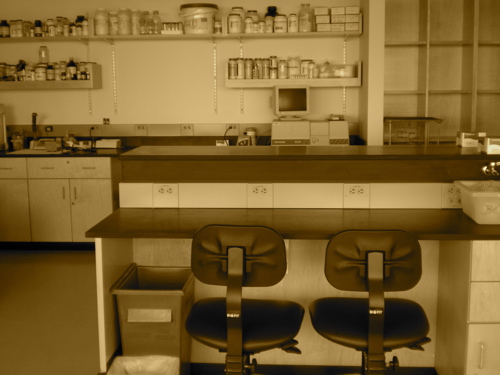Difference between revisions of "20.109(S10):RNA to DNA by RT-PCR (Day5)"
(→Introduction) |
(→Protocols) |
||
| Line 77: | Line 77: | ||
</center> | </center> | ||
| − | + | ===Part 3: WAC Session=== | |
| − | + | ===Part 4:Run RT-PCR products on gel=== | |
| − | + | After the RT-PCR is completed, students will prepare aliquots and load them onto gels... the teaching faculty will hang around till the gels are done running and post the images online, plus store the sample remainders in the freezer until next time. | |
==For next time== | ==For next time== | ||
==Reagent list== | ==Reagent list== | ||
Revision as of 20:15, 14 January 2010
Contents
Introduction
The amount of RNA recovered after a column purification is quite small. Thus, in the next step of SELEX, you must increase this small amount of RNA in a stable way. First (today) you convert it to DNA and amplify it, using RT-PCR. Then (next time), you will perform a second in vitro transcription reaction to make more of the RNA aptamer. For this process to work, the 6-5 and 8-12 aptamers must amplify at the same rate, a fact that has been proven for these particular aptamers under the conditions that we are using.
The RT in RT-PCR here stands for reverse transcription, that is, making DNA from an RNA template. We will use a 1-step RT-PCR kit from Qiagen, though the two procedures (reverse transcription and PCR) can be performed separately. The Qiagen kit utilizes a cocktail of two different RT enzymes: Omniscript and Sensiscript, the latter optimized to detect very low abundance sequences. After reverse transcription, these enzymes are inactivated, and a heat-sensitive polymerase is activated so PCR can begin. In sum, the reactions will run for two hours, and we'll spend this time meeting with the writing across the curriculum faculty.
Room in this intro to preview how the binding assay works, or discuss other sundry topics of interest such as the role of natural aptamers in vivo, why heme signaling is interesting, uses of aptamers in therapeutics, use w/ribozymes, etc.
Protocols
Part 1: Recover RNA
- Centrifuge your samples at max speed for 15 minutes.
- You and partner can balance your tubes against each other.
- Collect the supernatants into a temporary waste bottle, such as a 15 mL conical tube.
- Add one mL of 70-80% ethanol to each sample, and vortex vigorously.
- Spin for two minutes at max speed.
- Repeat the wash step with 1 mL of fresh 70-80% ethanol.
- Dry your samples in the fume hood for 10 minutes, then resuspend each one in 44 μL of RNase-free water.
Part 2: RT-PCR
HAVE THEM DO THE CONTROL I DID, OF MAKING SURE 6-5 AND 8-12 AMPLIFY AT SAME RATE?
- The thermal cycler will be preheated to 50 °C while you prepare your samples. This is required for the procedure to work optimally.
- Set up your reactions on a cold block as usual. From one of the shared stocks, pipet 30 μL of Master Mix into each well-labeled PCR tubes.
- In the interests of economy, we will not run control reactions this time. However, if you wanted to test for contamination of your reaction, what component would you leave out?
- Add 20 μL of your recovered RNA to the Master Mix.
- The following thermal cycler program will be used:
| Segment | Cycles | Temperature (° C) | Time | Purpose |
|---|---|---|---|---|
| 1 | 1 | 50 | 30 min | reverse transcription |
| 2 | 1 | 95 | 15 min | activate polymerase, deactivate RT enzymes, denature template |
| 3-5 | 20 | 94 | 30 sec | denature (PCR) |
| 57 | 1 min | anneal (PCR) | ||
| 72 | 1 min | extend (PCR) | ||
| 4 | 1 | 72 | 7 min | final extension |
Part 3: WAC Session
Part 4:Run RT-PCR products on gel
After the RT-PCR is completed, students will prepare aliquots and load them onto gels... the teaching faculty will hang around till the gels are done running and post the images online, plus store the sample remainders in the freezer until next time.
